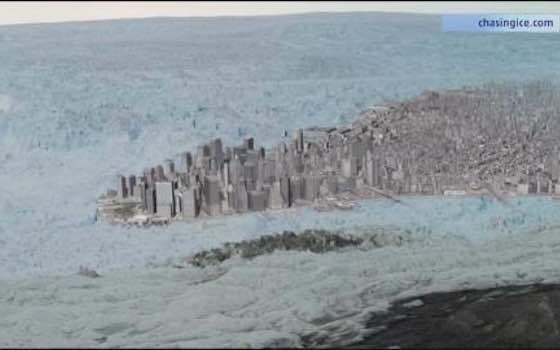- MENU
- HOME
- SEARCH
- WORLD
- MAIN
- AFRICA
- ASIA
- BALKANS
- EUROPE
- LATIN AMERICA
- MIDDLE EAST
- United Kingdom
- United States
- Argentina
- Australia
- Austria
- Benelux
- Brazil
- Canada
- China
- France
- Germany
- Greece
- Hungary
- India
- Indonesia
- Ireland
- Israel
- Italy
- Japan
- Korea
- Mexico
- New Zealand
- Pakistan
- Philippines
- Poland
- Russia
- South Africa
- Spain
- Taiwan
- Turkey
- USA
- BUSINESS
- WEALTH
- STOCKS
- TECH
- HEALTH
- LIFESTYLE
- ENTERTAINMENT
- SPORTS
- RSS
- iHaveNet.com: Environment

In an attempt to collect evidence of climate change for their documentary 'Chasing Ice', a team of filmmakers ventured to Greenland, and ended up capturing the largest event of a glacier ever recorded.
A large chunk of ice broke off a glacier in Greenland on June 12, 2023. The iceberg, which is estimated to be the size of Manhattan, broke off of the Helheim Glacier.
The break-off is a reminder of the rapid melting of Greenland's ice sheet. The ice sheet is losing mass at an alarming rate, and scientists believe that it could be completely gone by the end of the century.
The melting of Greenland's ice sheet is a major contributor to sea level rise. As the ice melts, it adds water to the oceans, which causes sea levels to rise. Sea level rise is a serious threat to coastal communities around the world.
The break-off of the iceberg in Greenland is a wake-up call. It is a reminder that climate change is real and that it is having a devastating impact on our planet. We need to take action to reduce our emissions and mitigate climate change before it is too late.
Glacier calving, or the breaking apart of glaciers, is a natural and common occurrence in Greenland and other glaciated regions. It is a process where chunks of ice break off from the front of a glacier and form icebergs as they enter the ocean. While I don't have access to real-time news, here are some general points about glacier calving in Greenland:
Dynamics of Glacier Calving
Glacier calving typically happens when the ice at the terminus of a glacier becomes unstable and fractures. Factors such as melting at the glacier front, the pressure of the ice, and oceanic or atmospheric conditions can contribute to the calving process.
Greenland's Glaciers
Greenland is home to numerous large glaciers, including the Jakobshavn Glacier, the largest in the Northern Hemisphere. These glaciers have been experiencing accelerated melting and retreat due to climate change, resulting in increased calving events.
Impact on Sea Level Rise
Glacier calving contributes to sea-level rise as the ice that breaks off from the glacier enters the ocean. However, it's important to note that the rate and extent of sea-level rise are influenced by various factors, including ice melt from the ice sheet's interior and thermal expansion of seawater.
Monitoring and Research
Scientists closely monitor Greenland's glaciers to better understand their behavior and the factors contributing to their retreat. This involves using satellite imagery, ground-based observations, and other monitoring techniques to track changes in ice flow and calving events.
More Environment & Climate Change ...
- 5 Radical Takeaways from the Pope's Letter on Climate
- A Green-Energy Founding Father
- We're All Taking Dirty Pictures
- Faking It While the World Burns
- This Oil Spill Hits Close to Home
- A Fossil-Fueled Fantasy
- The Pentagon Makes War on Alaska's Pristine Wilderness
- Climate Denial Syndrome Sweeps Wisconsin
- How Climate Change and Resource Scarcity Are Upending World Politics
- Virginia Is for Dirty-Energy Lovers
- Humanity's War on Wildlife
- Making Green Cool Again in Hungary
- David and Goliath in the Amazon
- NASA Warns of 'Megadroughts'
- Our Growing Carbon Emissions
- Global Warming Triggered Syria War
- Round-the-World Solar Flight Takes Off
- 10 Extreme Weather Facts
- New York City Sea Level Rises
- Alaskan Glaciers Disappearing
- Leather Sludge New Bio-Fuel Source
- Why the Ocean is Turning More Acidic
- Why Whales Beach Themselves
- Termites Fight Climate Change
- Gas-Guzzlers On Road To Extinction
- Technology & Transformation
- Ecuador: All You Need Is Love and Oil?
- China Pulls Critical Pollution Documentary Offline
- Forging Our Future
- Green Believers
- The Glaciers Are Talking to Us
- Bald Eagles Nesting In New York City For First Time In 100 Years
- Asian Pollution Messing With U.S. Weather
- Instagram Account Shows Reality of Climate Change
- Keystone Pipeline Would Emit Tons of Greenhouse Gases
- Why You Can't Throw Away Batteries
- Road Salt Is Worse Than You Think
- Arctic Not Cold Enough for Polar Bears
- Doomsday Clock & Climate Change
- Sea-Level Accelerating Faster Than Previously Thought
- 6 Countries Dictate Planet's Future
- Manhattan Size Glacier Breaks Apart
- Opinions Split on Fracking Benefits
- Bad News for Sea Level Rise
- 2014 Hottest Year On Record According To NASA
- While Our Planet Melts, GOP Pleads Ignorance
- The Myth of the Wild
- Plastic Bags are Not a Need - Just a Bad Habit
- Environmental Security: Conflict or Cooperation?
- Beyond The Water-Food-Energy-Climate Nexus
- Climate Change Report Sounds Alarm for Planet Earth
- Genesis, Mother Nature and Environmental Stewardship
- Global Climate Change: Calling All Pagans
- Chicken Little 'Science'
- Climate Change and Interstate Conflict
- Fracking: A Deadly Power Surge
- Inhospitable Earth -- Compared to What?
More Environment & Climate Change ...
"Manhattan Size Glacier Breaks Apart "